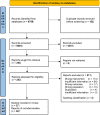This is a preprint.
Safety of COVID-19 vaccines, their components or their platforms for pregnant women: A rapid review
- PMID: 34127978
- PMCID: PMC8202435
- DOI: 10.1101/2021.06.03.21258283
Safety of COVID-19 vaccines, their components or their platforms for pregnant women: A rapid review
Update in
-
Safety of components and platforms of COVID-19 vaccines considered for use in pregnancy: A rapid review.Vaccine. 2021 Sep 24;39(40):5891-5908. doi: 10.1016/j.vaccine.2021.08.034. Epub 2021 Aug 13. Vaccine. 2021. PMID: 34489131 Free PMC article. Review.
Abstract
Background: Pregnant women with COVID-19 are at an increased risk of severe COVID-19 illness as well as adverse pregnancy and birth outcomes. Many countries are vaccinating or considering vaccinating pregnant women with limited available data about the safety of this strategy. Early identification of safety concerns of COVID-19 vaccines, including their components, or their technological platforms is therefore urgently needed.
Methods: We conducted a rapid systematic review, as the first phase of an ongoing full systematic review, to evaluate the safety of COVID-19 vaccines in pregnant women, including their components, and their technological platforms (whole virus, protein, viral vector or nucleic acid) used in other vaccines, following the Cochrane methods and the PRISMA statement for reporting (PROSPERO-CRD42021234185).We searched literature databases, COVID-19 and pregnancy registries from inception February 2021 without time or language restriction and explored the reference lists of relevant systematic reviews retrieved. We selected studies of any methodological design that included at least 50 pregnant women or pregnant animals exposed to the vaccines that were selected for review by the COVAX MIWG in August 2020 or their components or platforms included in the COVID-19 vaccines, and evaluated adverse events during pregnancy and the neonatal period.Pairs of reviewers independently selected studies through the COVIDENCE web software and performed the data extraction through a previously piloted online extraction form. Discrepancies were resolved by consensus.
Results: We identified 6768 records, 256 potentially eligible studies were assessed by full-text, and 37 clinical and non-clinical studies (38 reports, involving 2,397,715 pregnant women and 56 pregnant animals) and 12 pregnancy registries were included.Most studies (89%) were conducted in high-income countries. The most frequent study design was cohort studies (n=21), followed by surveillance studies, randomized controlled trials, and registry analyses. Most studies (76%) allowed comparisons between vaccinated and unvaccinated pregnant women (n=25) or animals (n=3) and reported exposures during the three trimesters of pregnancy.The most frequent exposure was to AS03 adjuvant in the context of A/H1N1 pandemic influenza vaccines (n=24), followed by aluminum-based adjuvants (n=11). Aluminum phosphate was used in Respiratory Syncytial Virus Fusion candidate vaccines (n=3) and Tdap vaccines (n=3). Different aluminum-based adjuvants were used in hepatitis vaccines. The replication-deficient simian adenovirus ChAdOx1 was used for a Rift Valley fever vaccine. Only one study reported exposure to messenger RNA (mRNA) COVID-19 vaccines that also used lipid nanoparticles. Except for one preliminary report about A/H1N1 influenza vaccination (adjuvant AS03) - corrected by the authors in a more thorough analysis, all studies concluded that there were no safety concerns.
Conclusion: This rapid review found no evidence of pregnancy-associated safety concerns of COVID-19 vaccines that were selected for review by the COVAX MIWG or of their components or platforms when used in other vaccines. However, the need for further data on several vaccine platforms and components is warranted given their novelty. Our findings support current WHO guidelines recommending that pregnant women may consider receiving COVID-19 vaccines, particularly if they are at high risk of exposure or have comorbidities that enhance the risk of severe disease.
Conflict of interest statement
Figures
References
-
- Herzog LM, Norheim OF, Emanuel EJ, McCoy MS. Covax must go beyond proportional allocation of covid vaccines to ensure fair and equitable access. BMJ. 2021;372:m4853. - PubMed
Publication types
Grants and funding
LinkOut - more resources
Full Text Sources

